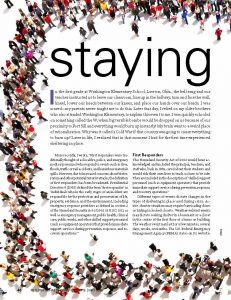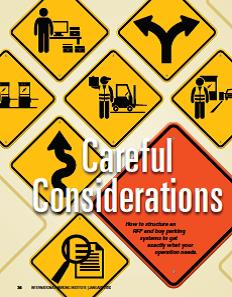IPI’s volunteer leaders have been hard at work via the association’s committees, advancing the parking profession with programs, initiatives, and research. Here’s what they’ve been doing so far this year.
been doing so far this year.
Awards of Excellence Committee
IPI’s Awards of Excellence competition for new facilities, surface lots, innovative programs, sustainable new construction, and restoration of existing structures never ceases to amaze the committee. Committee members review the entries each year; at press time, members just completed our second year of online judging and are looking forward to turning it up a notch in the 2017 competition by increasing the total number of overall entries. Every year, it’s tougher to choose the beautifully designed facilities, technology-driven innovative programs, and overall architectural achievement winners.
Prior to opening the upcoming 35th annual competition, the committee will be streamlining the category criteria and looking at ways to increase the total number of entries. The committee will also be moving the timing of the competition’s timeline for entries to begin in summer 2016 with a deadline moving to late fall 2016. For more information, visit parking.org/aoe.
CO-CHAIRS: Rick Decker, CAPP, and Anderson Moore
Consultants Committee
The Consultants Committee is participating in numerous IPI initiatives that cross committee lines. The committee is supporting the Parking Matters® initiative to create case studies that demonstrate just how critical parking programs are to our cities, campuses, and transportation networks. In addition, the consultants are actively engaged in supporting IPI’s Green Star Exhibitor program, which gives recognition to companies that provide sustainable solutions, products, and services that are in line with IPI’s ustainability Framework. We are working with the Smart Card Alliance to generate a timely and relevant update to the EMV and Parking White Paper and help guide parking professionals through the transition to Europay MasterCard Visa (EMV) technology. And we are bringing back the Consultants Talk Back panel to the 2016 IPI Conference & Expo, this time with a focus on
mobility and alternative transportation.
CO-CHAIRS: John Bushman, PE, and Mark Santos, PE
Education Development Committee
Last summer, the Education Development Committee (EDC) welcomed several new members. The current committee, comprised of 16 volunteers, continues its tradition of effective and relevant output. The committee’s recent focus has included an update to the CAPP Resource Guide, a refresh of the CAPP practice exam, and the development of new online courses, including “Technology Trends” and “Foundations of Finance.” These two courses, as well as other online courses, are available for purchase through IPI. It is important to note that several of the courses have been provided to state and regional parking organization workshops as part of their front-line, in-person training efforts.
Recently, Denny Smith, PhD, joined the IPI staff and is working with several committee members to further professionalize our education products. Next in the queue for the EDC is to work closely with the USGBC and develop course content in support of the Green
Garage Certification process (now known as Parksmart).
CO-CHAIRS: Tom Wunk, CAPP, and Josh Cantor
ITS Parking Task Force
It has been an exciting couple of months within the ITS Parking Task Force as we have been actively pursuing presentation opportunities nationwide. We were selected to present at the New England Parking Council Spring Conference & Tradeshow in late March and were offered a special opportunity to present during the IGNITE session at the 2016 IPI Conference & Expo. Part of the task force’s recent efforts has been to format our current presentation to the IGNITE timeframe of five minutes, which has been an interesting challenge. We were also fortunate enough to have an article published in the February edition of The Parking Professional that highlighted a traffic management center (TMC) and our objectives. Lastly, we are putting the finishing touches on the Tennessee DOT-TMC visit, which will serve as the only offsite facility tour offered at this year’s IPI Conference & Expo in Nashville, Tenn.
CO-CHAIRS: Jason Jones and Ken Smith, CAPP
Membership Committee
New members, first-time attendees, and member prospects will have plenty on tap to welcome them at the 2016 IPI Conference & Expo, May 17–20, in Nashville. Among them:
- A new-member/first-timer orientation that will include a fun speed-networking social session featuring topics designed to get the conversation flowing.
- Conference morning meet-ups in Central Perks, a relaxed coffeehouse setting, with membership committee members on hand to greet. Look for membership committee members wearing big buttons that say “Ask Me Why I (Heart) IPI,” and share your personal stories about how IPI benefits you, your career, and your organization.
By reaching out and growing membership, we will add new voices and ideas and further expand IPI’s sphere of influence worldwide. Ultimately, our goal is to advance the parking profession, and one way to do that is to help members access all the benefits of membership—most of all, offering the ability to connect, share, and learn from peers.
Also in the works, an update to IPI’s short but sweet member video. Stay tuned!
CO-CHAIRS: Allen Corry, CAPP, and Mark Lyons, CAPP
Parking Matters Committee
Parking Matters. We know it, but to many outside stakeholders, which include city managers, elected officials, university decision-makers, airport and hospital executives, urban planners, etc., the proof is seeing real parking solutions to real challenges.
That’s why the Parking Matters Committee is on a mission to gather case studies that tell our story across all sectors. Have a case study to share? Let us know, and we’ll send you a case study form to submit. At this month’s IPI Conference & Expo, we’ll also be videotaping industry leaders, capturing compelling parking success stories for a series of videos. And Parking Matters Marketing & Communications Awards winners will be announced. This year, more than 10 programs will receive honors, with three capturing Best of 2016 awards. Look for their great ideas and marketing takeaways in the July issue of The Parking Professional.
We’ll also be unveiling an (unfortunately) much-needed tool for parking professionals on suicide prevention, response, and recovery. Also, if you see reporters or TV crews in the Expo Hall, that’s our PM media outreach initiative up close and personal, improving perceptions about parking.
CO-CHAIRS: Gary Means, CAPP, and Vanessa Solesbee
Parking Research Committee
The mission of the Parking Research Committee is to help our members and industry take a deeper look into topics that are both timely and useful. As such, our group has been allocating its recent effort on a project that could help define the parking industry. Our group, in conjunction with staff and the Membership Committee, is hosting an ongoing survey to derive the overall size (spaces, revenue, and type) of the parking industry—first, within IPI’s membership. The survey went to IPI members recently and will be compiled and analyzed in 2016; all participants will receive a copy as soon as it is released. The ongoing survey is likely a jumping off point for bigger efforts beyond IPI’s membership but serves as a starting point and foundation for this important exercise.
In addition, members of our committee are also beginning parallel efforts that will create a library of relevant and timely published research for IPI membership, create succinct information about mobile applications, and embark on research about the true effects of paid parking in an urban environment.
CO-CHAIRS: Irena Goloschokin and Brett Wood, CAPP
Professional Recognition Program Committee
This program has always been about one thing: parking industry people. Whether individually or as a team, their outstanding go-getter attitudes build the organizations that are leading the way for others to follow.
This year, the new Emerging Leader of the Year category was added to the Professional Recognition competition. The committee also reviews the nominations for lifetime achievement and staff member, supervisor, organization, and parking professional of the year. It’s always a difficult playing field, but the committee is happy to see what others are doing in the industry and committed to choosing those to honor at the parking.org/prp.
In the near future, the committee will be gearing up to move the timing of the ompetition’s call for nominations to begin in summer 2016 with the deadline moving to late fall 2016. For more information, visit parking.org/prp.
CO-CHAIRS: Dan Kupferman, CAPP, and Wayne Mixdorf, CAPP
Safety and Security Committee
The Safety and Security Committee is made up of a group of professionals with a wealth of experience in safety, security, and incident command scenarios.
Current committee projects include:
- Senior driving campaign. IPI is working with AAA to launch a campaign to educate senior drivers about parking safely.
- Inclement weather survey. This initiative will provide resources to improve the safety and security of parking patrons, staff, and facilities. The survey will be distributed to IPI membership in fall 2016.
- Suicide Prevention Task Force. In an effort to help member agencies, IPI is working in cooperation with mental health and suicide prevention experts to develop education regarding awareness, prevention, response, and recovery to incidents of suicides taking place within parking facilities.
- NCS4: IPI and NCS4 (the National Center for Spectator Sports Safety & Security) are developing member education to enhance event safety. (See p. 24 for more.)
CO-CHAIRS: Bruce Barclay, CAPP, and Geary Robinson, PhD, CAPP
State & Regional Committee
When IPI asks state and regional associations (SRA) how we can better support their success, the resounding answer is with membership management, including marketing, recruitment, value proposition, and retention.
The IPI/SRA liaison program is in high gear with more than 10 liaisons building upon and fostering new lines of communication, and IPI set forth to develop an education series surrounding membership management for SRA volunteers. With the successful premiere of the “Thirty Minutes of Education (TME), Gearing Up to Grow Membership,” IPI provided its first quarterly expert-facilitated talk for the SRAs.
On Feb. 24, Peggy Hoffman, CAE, president of Mariner Management, talked about the top three needs to jump-start marketing, additional resources and case studies, and two action items to get started. IPI looks forward to continuing the engagement of industry experts for SRA volunteers in the TME series. Future TME topics may include increasing the member value proposition, raising membership rates, and finding new revenue sources.
CO-CHAIRS: Bridgette Brady, CAPP, and David Onorato, CAPP
Sustainability Committee
When this issue went to print, the Sustainability Committee was gearing up to review applicants for the Green Star Exhibitor program at the 2016 IPI Conference & Expo. Green Star highlights exhibitors who have a commitment to sustainability and/or provide products or services that help organizations meet their sustainability goals.
The committee is also developing case studies on sustainable projects that will be available to the IPI community. Case studies under development include bike access, lighting, ventilation, and electric transportation. The committee will provide a full slate of
articles to The Parking Professional, including stories on stormwater management and bike education programs.
CO-CHAIRS: Irma Henderson, CAPP, and Brian Shaw, CAPP
TPP-2016-05-Constant Progress
 By Mandy Bowers
By Mandy Bowers


 By Chris Yigit
By Chris Yigit



